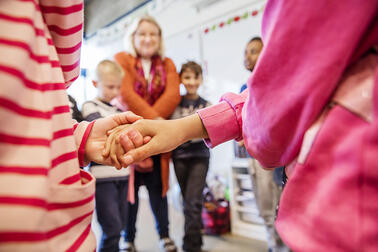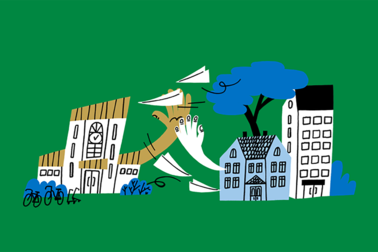
A few years ago, Helsinki launched a bullying prevention programme, KVO13, which guides activities in all of the city’s schools. Puistopolku Comprehensive School developed its own tactical operating model based on the programme, which has now been taken into use.
– A common model lowers the threshold for all adults to tackle bullying at school. By the way, an active teacher can be perceived by the pupils as always meddling or “not liking me”, says school social worker Nora Pehrsson.
The bullying intervention model concerns the entire Puistopolku Comprehensive School with 860 pupils in grades 1–9.
– Investments in the prevention of bullying are returned many times over. Pupils’ well-being increases and the staff cope better at work, says a convinced principal Pertti Tossavainen.

Bullying is not the same as an argument
At Puistopolku Comprehensive School, bullying has been strictly defined, as not all bad behaviour is bullying. When someone is bullied, they are repeatedly subjected to mental or physical activity that is harmful or unpleasant.
Bullying is also not the same as an argument: there is an imbalance of power between the bully and the bullied, with the defenceless being oppressed by the stronger. Arguments are transient and do not always involve the same child or young person.
– Bullying is a group phenomenon, and therefore merely intervening with the interaction between the bully and the bullied is not enough. Having an impact on the whole community is more important. When classmates send a message that bullying is not acceptable, it will have a stronger impact, Tossavainen says.
That’s why pupils’ empathy and interaction skills are important. They can help prevent bullying.
– When the pupils feel that they belong in the community, there is less bullying, school psychologist Eetu Ahonen says.
Prevention also includes the competence of school staff: how well adults are able to observe situations and how quickly they intervene. It is also important that the adult explains why they are interfering with the pupils’ language or jokes. Even if the young people do not mean any harm, someone may still experience it that way because of their past experiences.

Mobile phone parking in use
In the Puistopolku model, the different forms of bullying were explained to the school staff and pupils, so that everyone understands what offensive behaviour can entail.
Silent bullying includes talking behind other people’s back, making faces and isolating people from a group. Verbal bullying includes jeering, name-calling and mimicking. Physical bullying includes pushing, hitting and taking other people’s possessions. Cyberbullying takes many forms such as spreading rumours, making nasty comments, sharing private information and blackmailing.
-The primary responsibility for the pupils’ social behaviour lies with the guardians.
Bullying on social media is often difficult for schools to tackle.
– The school can reduce the chances of it taking place at school. If pupils are allowed to use their phones, they might take photos in class, for example, Tossavainen explains.
Mobile phones are not used in Puistopolku Comprehensive School during lessons. Mobile phone parking has been included in the school rules, and parents and guardians have given plenty of positive feedback about the rule.
– The primary responsibility for the pupils’ social behaviour lies with the guardians, the principal notes.
Sometimes bullying can be the reason why a young person is absent from school or experiences anxiety. It can also be the root cause of learning difficulties.
– It can take a long time before bullying is revealed during the private conversations between a school social worker and a pupil. My job is to support the young person, and we will start to tackle the situation together, Pehrsson explains.
A school social worker can also help a bully shake off the harmful behaviour.

Every case must be investigated
Puistopolku developed its model for tackling bullying by reviewing the operating models used by other schools around Finland and adapting them to its needs. A bullying survey for the teachers was also realised.
– The voice of the children and young people has been heard a lot in all cases of bullying, and the feedback received has affected the process, Pehrsson says.
The principal stresses that every case of bullying that comes to light must be investigated.
– There is no such thing as a school or workplace with zero bullying. It’s important for the young people or their guardians to let others know if bullying takes place.
If a suspicion of bullying arises in Puistopolku, teachers who know the pupils in question best will begin to investigate the matter: in a primary school, this means the pupil’s own class teacher and in secondary school their homeroom teacher.
– If necessary, pupil welfare and named adults from the Kiva or Sopu teams will also be involved. The joint responsibility and intervention efforts are divided between several adults.
The class or homeroom teacher will talk to the pupils and record the information on a bullying form. Teachers have instructions on how and at what stage to contact a pupil’s guardians.
If the bullying case is complex and long-lasting, the school can also consult the Children of the Station K-0 team at any point. If bullying with the possibility of crime occurs at school, the police will always be involved in the process.

There is no such thing as a school or workplace with zero bullying. It’s important for the young people or their guardians to let others know if bullying takes place.
When the bullying case has been investigated in Puistopolku and an agreement between the parties has been reached, a decision on further measures will be made. An agreement on follow-up measures is always made as well. Through Wilma, the guardians of all pupils have been informed about the bullying intervention model, explaining the stages.
– I believe and hope that once we have gone through these together, it will prevent further bullying. Once young people know about the process, they won’t want to get involved in it, Pehrsson says.
Adults listen to young people
Vuosaari is the largest city district in Helsinki by population, and nine percent of all young people in Helsinki live there. Puistopolku Comprehensive School is an active player in various networks in the area, and the school works in close cooperation with youth work and the third sector, for example.
The school builds a sense of community and pupils’ inclusion by listening to the young people. When a young person feels that they are heard and met, they will also feel appreciated. For example, the school-specific results of the School Health Promotion study are reviewed with the pupils in Puistopolku.
– We listen to the pupils’ opinions and try to realise their suggestions. Together with the pupils, we also try to come up with concrete things that we can start improving, Ahonen explains.
A good everyday life at school consists of ordinary but important things such as a sense of security.
– I always try to emphasise that the school rules create a sense of security. The youth may fight back, but they don’t really want us to give in. Humane rigidity is part of our philosophy of appreciative interaction, says Tossavainen.
Text by Nina Dale
Photos by Laura Oja
This article is part of a series that introduces Helsinki's actions to build a good future together, for each of us.
#education2030 #helsinkilearns #helsinkieducationfuturecompetences


